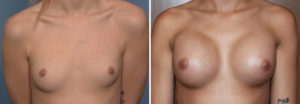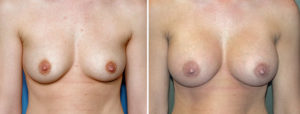Breast augmentation is one of the most dramatic of all the body contouring operations. In just an hour in most cases, the breast mound is enlarged and the entire shape of the chest wall changed through the insertion of a synthetic implant. While the operation is short and the change is immediate, the actual recovery from breast augmentation is much longer. The feel and shape of the breasts will go through a series of classic phases of recovery of which most patients are unaware or do not expect fully.
For whatever reason, many breast augmentation patients seem to expect that the final shape and look of the breasts are achieved in days to just weeks. Many of the questions in the first month after surgery are very typical and range from concerns about size, shape, feel and symmetry between the two breasts. While a breast implant causes an immediate size increase, it does so without the skin yet being adapted to the pressure of this volume increase. When this is combined with the swelling and bruising that occurs from the trauma of surgery, there is a predictable series of phases that one can expect in their breast augmentation recovery.

The second phase of breast augmentation recovery is from the first to the third week after surgery. The very visible swelling of the breasts begins to subside and whatever bruising occurred is completely absorbed. The breasts do not feel quite as tight and they may not look as high. They will not feel quite as stiff although they are still not soft and natural feeling. There will be persistent numbness on the lower pole breast skin and the nipples may still feel hypersensitive with shooting sensations or easy irritability. They will likely be some persistent asymmetry of the breasts and this should not be a concern at this point.

The fourth and final phase of breast augmentation recovery is from six weeks to three months after surgery. It is during this time that all of the residual effects of the change are realized. The breasts are soft and fully relaxed, nipple sensation is normal and most of the numbness of the skin has resolved. This is the time to become critical about the final results of the surgery in terms of implant size and asymmetry.
These four phases of breast augmentation recovery show that the time to be concerned about how the results look is not until three months after surgery. Patients will have many understandable concerns along the way but most of these will be self-resolving with time and tissue adaptation.
Dr. Barry Eppley
Indianapolis, Indiana


